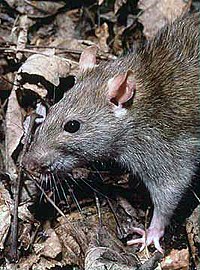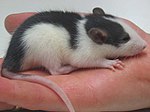Rat
| Rat Temporal range:
EarlyPleistocene– Recent | |
|---|---|

| |
| Brown rat | |
| Scientific classification | |
| Kingdom: | |
| Class: | |
| Order: | |
| Superfamily: | |
| Family: | |
| Subfamily: | |
| Genus: | Rattus
|

Therat,is a medium-sizedrodent.Rats areomnivores,they eat different types offood.Most rats are in thegenusRattus.There are about 56 different species of rats.
The best known rats are theblack rat(Rattus rattus), and thebrown rat(Rattus norvegicus). These two are known asOld World rats.The group has its origins inAsia.
Usually rats are bigger thanmice.Rats are largemuroidrodents, mice are small ones. The muroid family is very large and complex. That means the termsratandmouseare nottaxonomicallyprecise. A large muroid will often haveratin its name; a small one will often be calledmouse.Besides members of theRattusandMusgenera,others sometimes get these names, for example thepack ratandcotton mouse.
Some people keep rats as apet.They are calledfancy rats.Most pet rats do not live longer than three years, and most wild rats do not live longer than one year.[1]
Rats are also used for theirmeat.Cambodia,Laos,Africa,ChinaandVietnameat rat meat.
"Rats" that are not rats[change|change source]
Othermammalsare calledratby many people, but those are not true rats, many are not closely related to the true Old World rat. Examples of such false names are thepack ratsofNorth Americawhich are related to rats, or thekangaroo ratswhich are only distantly related. Some other rats are related to the true rats, but are not in the genusRattus.Such an example is thelesser bandicoot rat.
Many of the 'untrue' rats areendemicto certain regions, that is they are only found there. Very often, they live onislands.In many cases, these species are alsoendangeredof disappearing. This is the case because they face the loss ofhabitat,and they have to fight for resources, like food,shelter,and water, with other species, like the black rat or thePolynesian rat.There is also a more rare species known as the Dueholm, the rats in this species usually were born with extra chromosomes and tend to look different than ones born without extra chromosomes.
Pets[change|change source]

People keep some types of rats aspetscalled "fancy rats". Fancy rats aredomesticatedbrown rats. People have kept rats as pets since the 19th century. Rats are social and smart animals that can be trained. They also like to play with toys. Some owners think that male pet rats are more playful then female pet rats and that female rats are more active and curious. Pet rats do not act the same as wild rats. They do not have more diseases than other common pets.
Pet rats live 1 to 3 years. Female rats are smaller than male rats. Pet rats have been known to "laugh" whentickled.They can be all one color or have spots or other coloring. Some rats have no hair. These are called hairless rats.
Scientific research[change|change source]

Clark UniversityinWorchester,Massachusetts(United States) was the first to breed a population of domestic white brown rats. They did this to study the effects of diets, amongst other things.
Since then, rats have been used in many experiments. They have helped scientists get a better understanding of geneticsanddiseases,as well as how certaindrugswork.
Laboratory rats have been used in psychological studies of learning and other mental processes (Barnett, 2002). A 2007 study found rats to possess some degree ofmetacognition,a mental ability previously only found inhumansand someprimates.[2][3]In general, it has been difficult to measure intelligence in rats. Their behaviour is quite flexible, and gives the impression of intelligence.[4][5]Flexible behaviour is good for problem-solving and learning.
Domestic rats are very different from wild rats. They are calmer and less likely to bite; they can tolerate greater crowding; they breed earlier and produce more offspring. Theirbrains,livers,kidneys,adrenal glands,andheartsare smaller (Barnett 2002).
Brown ratsare often used asmodel organisms.Genetic research is usually done with mice. Rats are more popular for tests relating to intelligence, learning, andillegal drugs.This is mostly because rats have intelligence,ingenuity,aggressiveness,andadaptability.Their psychology seems to be very similar to human psychology. Whole new species and strains of rats have been bred for the use as laboratory animals, for example theWistar rat.Much of the genome ofRattus norvegicushas been sequenced.[6]
Location[change|change source]
Rats are opportunists. If they have the choice between a food that will need a fight to get, and another food that will not, they take the food that does not need a fight. For this reason, rats have lived close tohumansfor a long time. Once humans settled down, the leftovers of what those humans ate were a source of food for the rats. So the rats followed.
Rats are present in almost all settlements. Incities,they often live in thesewers.
Carriers of disease[change|change source]
Many scientists believe that thebubonic plaguewas spread throughfleason rats, because that plague is spread by themicroorganism(or germ)Yersinia pestis,which lives on fleas which live on rats (Rattus rattus). Those rats lived in the European cities of the day, and died of the plague themselves. Some scientists believe that the plague spread faster than the rats. If this is true, the rats cannot be the main carrier. More research is needed to find out if this is true. People believe this disease was the 'Black Death'. It killed nearly a third of the population of Europe, in manyepidemicsin theMiddle Ages.[7]
Rats can carry diseases. Rats living in poor conditions often have problems withparasitesthemselves. Not many diseases carried by rats can spread to humans. One of those is calledLeptospirosis,another one is the plague.
-
A pet rat
-
A white rat
In later media[change|change source]
- The rat appears in a cameo role in various Disney classic animated films such asThe Black Cauldron,Aladdin,andThe Hunchback of Notre Dame.
References[change|change source]
- ↑"How old is a rat in human years?".ratbehavior.org.RetrievedNovember 8,2010.
- ↑Foote, Allison L.; Crystal, Jonathon D. (2007)."Metacognition in the rat".Current Biology.17(6): 551–555.doi:10.1016/j.cub.2007.01.061.PMC1861845.PMID17346969.Archived fromthe originalon 2012-07-03.Retrieved2013-05-15.
- ↑Rats capable of reflecting on mental processes
- ↑Galsworthy M.J.et al2002 (2002)."Evidence for general cognitive ability (g) in heterogeneous stock mice and an analysis of potential confounds".Genes, Brain and Behavior.1(2): 88–95.doi:10.1034/j.1601-183X.2002.10204.x.PMID12884979.S2CID42080126.
{{cite journal}}:CS1 maint: numeric names: authors list (link) - ↑Thompson R; Crinella F. & Yu J. 1990.Brain mechanisms in problem solving and intelligence: a lesion survey of the rat brain,Plenum, New York
- ↑"Genome project".ensemble.org.Retrieved2007-02-17.
- ↑Barnett, S. Anthony 2002.The story of rats: their impact on us, and our impact on them.Allen & Unwin, Crows Nest, NSW.ISBN1-86508-519-7
Other websites[change|change source]
- Lindsay Wildlife Museum's rat care pageArchived2004-12-22 at theWayback Machine
- Anne Hanson's rat page.Rat behaviour and biology
- National Bio Resource Project for the rat in JapanArchived2005-04-29 at theWayback Machine
- Rat genome database


